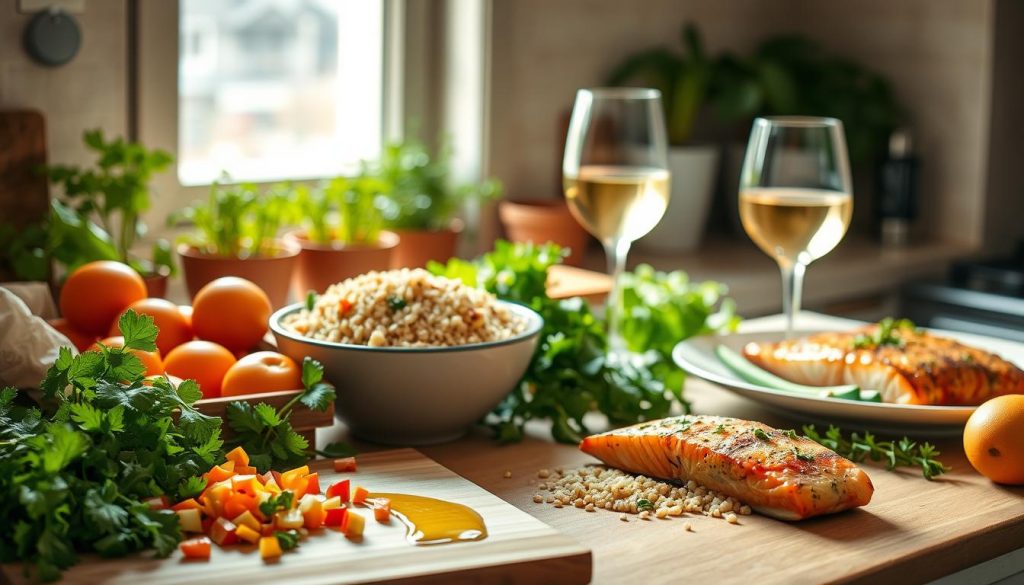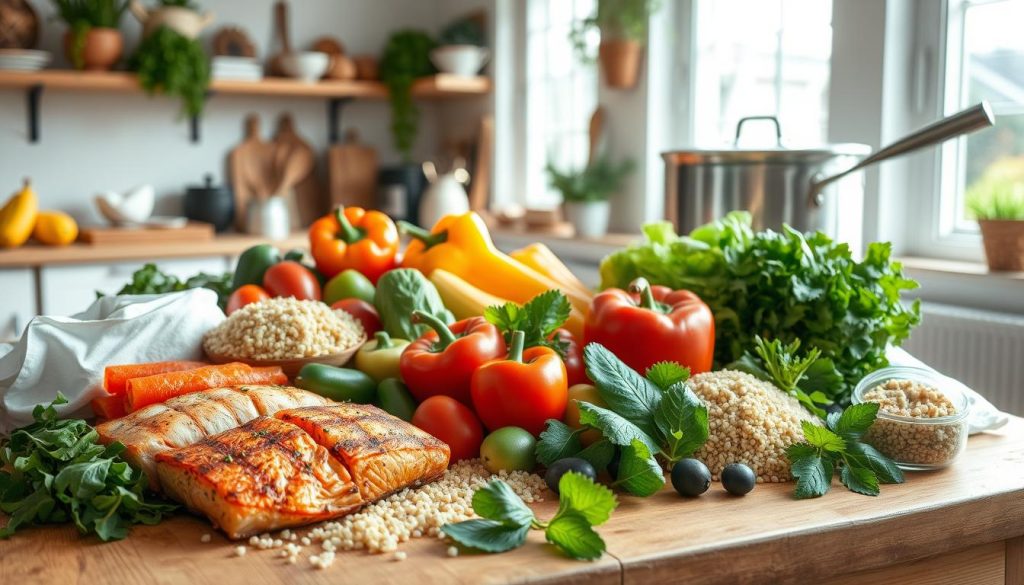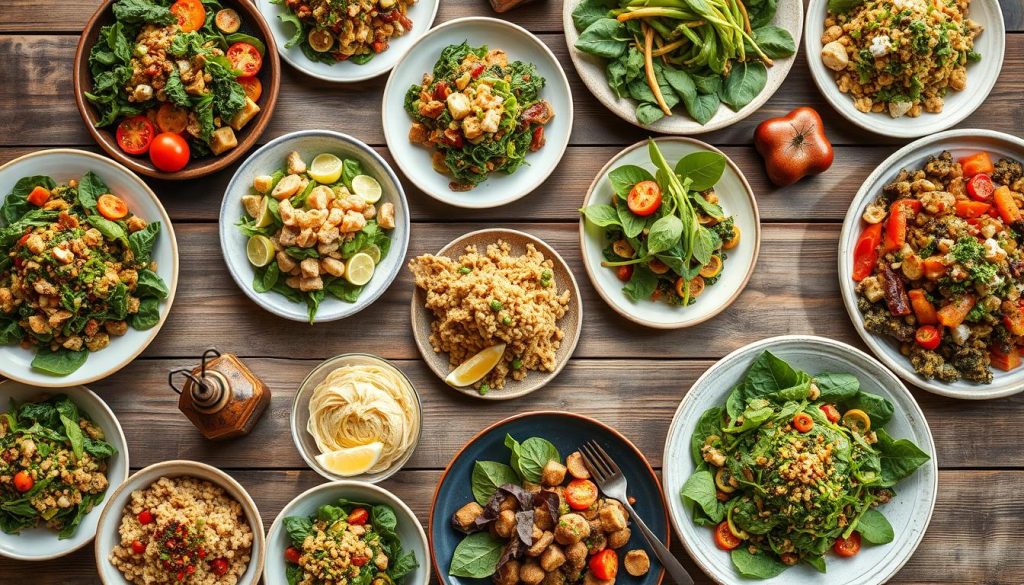This peek into 20 most-saved heart-healthy recipes embraces whole grains, lean proteins, and bright produce. The goal is steady wellness through balanced cooking.
Heart-friendly meals can unite flavor and well-being. People in the United States crave quick ideas that deliver lasting energy
Key Takeaways
- Whole grains bring fiber and help maintain balanced digestion.
- Lean proteins offer nutrients for muscle support.
- Fresh fruits and vegetables add vitamins for daily vitality.
- Simple meals encourage consistency in heart-focused habits.
- Weekly planning saves time and makes heart-smart choices easier.
Why Heart-Healthy Eating Matters
Eating meals rich in nutrients helps our bodies manage cholesterol and keep blood pressure stable. Many families use the best heart-healthy recipes to stay full of energy and protect their health for the long term. Foods packed with fiber and omega-3 fatty acids help keep arteries flexible, lowering the risk of heart problems.
Experts recommend a variety of dishes that are good for the heart. Lean proteins, fresh veggies, and whole grains are key to a strong diet. This way, you can make delicious meals for any day of the week.
Understanding Cholesterol and Blood Pressure
High levels of “bad” cholesterol can harm the circulatory system. Foods high in saturated fats and sodium increase blood pressure risk. The Mayo Clinic and other studies show that cutting down on trans fats and drinking plenty of water can help the heart.
Building a Balanced Plate
Combining bright produce, hearty grains, and lean proteins is a winning strategy. Try to fill half your plate with fruits and veggies. Leave space for good fats like nuts or avocado. This approach is a great starting point for trying the best heart-healthy recipes regularly.
Exploring 20 Most-Saved Heart-Healthy Recipes
These top heart-healthy dishes have caught the eye of many home cooks. Each dish combines lean proteins like salmon or chicken with vibrant veggies, whole grains, and less saturated fat. The American Heart Association suggests making small, tasty changes to avoid extra calories.
Think about starting your day with a warm oatmeal bowl topped with berries and nuts. Or, enjoy a zesty grilled fish taco for dinner. Busy families often prep ingredients ahead of time. They use fresh fruits for sweet treats and pair grilled chicken with quinoa or brown rice for a healthy lunch.
These recipes are loved for their flavor, ease, and health benefits. They show that even small changes can help keep the heart strong.
Incorporating the Best Heart-Healthy Recipes into Everyday Cooking
Starting healthy habits in the kitchen can be exciting. Simple steps like prepping ingredients weekly or using a Crock-Pot make it easy. This way, busy families can enjoy healthy meals without hassle.
Meal Planning for Heart Health
Planning meals ahead saves time and reduces stress. A weekend cooking session can prepare meals for the whole week. Store cooked grains and chopped veggies for quick meals.
This makes it easy to reheat balanced meals whenever you need them.
Key Ingredients to Keep on Hand
A well-stocked pantry boosts your cooking creativity. Keep whole wheat pasta, brown rice, and dried beans for filling meals. Canned tomatoes, low-sodium broth, and frozen veggies add flavor without taking up too much time.
Having fresh herbs, lean proteins, and olive oil ready encourages healthy choices. It helps you stay on track with your cooking goals.
Top Heart-Healthy Dishes for Busy Weeknights
Long days often mean we need quick meals that are good for us. Heart-healthy cooking ideas are perfect for this. They mix simplicity with great taste, making dishes that fit our busy lives. A few kitchen tweaks can make your meals fresh and healthy.
Smart Substitutions for Flavor
High-fat ingredients can be swapped for lighter options that taste great. Use reduced-fat cheese or Greek yogurt instead of sour cream. Olive oil and vegetable broths keep food moist. These changes make old favorites healthier and tastier.
Creating Time-Saving Meal Preps
Preparing ingredients ahead of time makes busy weeknights easier. Store cut veggies or marinated proteins in containers. Then, cook and assemble when you can. This method cuts down on mess and encourages more home cooking.
- Pre-chop peppers, onions, and carrots for fast stir-fries
- Batch-cook lean proteins for salads or wraps
- Combine whole grains in resealable bags for quick boiling
| Ingredient | Reason to Use |
|---|---|
| Extra-Virgin Olive Oil | Boosts flavor without heavy saturated fats |
| Low-Sodium Broth | Adds moisture while controlling salt intake |
Nutritious Heart-Friendly Meals That Kids Will Love
Feeding young taste buds with wholesome ingredients can be fun. Creativity makes mealtime exciting for kids. They love bite-sized shapes and bright colors.
Lightly baked chicken strips in whole grain breadcrumbs are tasty and healthy. Spinach smoothies mix sweet fruits with greens. They hide the taste of greens but keep the vitamins.
“I never knew my daughter would enjoy green veggies until I tried mixing them in a fruit shake,” says Anna Smith, a busy mom of two.
Fun presentations and familiar foods make kids excited about healthy meals. Homemade pita pizzas with fresh tomato sauce and low-fat cheese are a hit. Adding toppings like diced peppers or mushrooms makes them balanced and tasty.
Sharing meals and trying new things makes everyone happy. It turns every meal into a fun adventure.
How to Transform Popular Heart-Healthy Cooking Ideas into Easy Weeknight Dinners

Turning favorite dishes into quick meals is easy with the right plan. Use fresh produce, lean proteins, and spices to make any dish better. This way, you can enjoy heart-healthy meals even when you’re busy.
Adding layers of flavor is important. Use herbs, citrus, and low-sodium broths for depth. Beans, whole grains, and veggies add a satisfying bite that’s good for your health.
Soups and Stews for Comfort and Health
Warm soups with spinach or carrots are perfect for chilly nights. Pair lean turkey or chicken with beans for a protein-packed meal. These dishes show that healthy meals can be both comforting and quick.
Flavorful Salads and Wraps
Salads with olive oil or vinegar are a quick flavor boost. Whole wheat wraps with grilled fish or tofu and greens make a nutritious, easy dinner. This keeps your meals exciting and balanced all week.
Suggestions for Delicious Heart-Healthy Meals That Are Restaurant-Worthy
Many people think fine dining means heavy or loaded dishes. But, making upscale meals at home is easy and heart-friendly. Start with seared fish and fresh herbs for a burst of flavor. A sauce from roasted peppers or tomatoes adds a special touch.
Adding colorful veggies boosts taste and health. Chefs use simple touches like lemon slices or parsley to make dishes stand out. These tricks can transform any recipe into a memorable meal. They work great with the 20 most-saved heart-healthy recipes.
- Caramelize onions to bring out natural sweetness
- Experiment with citrus marinades for light tangy results
- Present foods on smaller plates for a refined look
Nutrient-rich meals can be fun. Try pan-searing, roasting, and creative presentation. These methods turn the 20 most-saved heart-healthy recipes into restaurant-quality dishes. Enjoy them right in your own home.
Adapting Easy Heart-Healthy Recipes for Dietary Restrictions
Many families want to change their favorite meals without losing flavor or nutrition. These changes let everyone enjoy great heart-healthy recipes. By swapping out ingredients, meals can stay tasty and interesting, even with dietary limits.
Using fresh veggies, whole grains, and new spices can replace usual ingredients. This way, everyone can enjoy meals together, no matter their dietary needs.
Low-Sodium Adjustments
Salt is often the main flavor, but herbs like thyme or rosemary can be just as good. Lemon zest, vinegar, and garlic powder add flavor without too much salt. Mixing these can make meals exciting and full of taste.
Gluten-Free Alternatives
For those who can’t eat wheat, quinoa or millet are great for sides. Flours from Bob’s Red Mill work well in pancakes or muffins. Oats that are gluten-free are also good, keeping baked goods tasty and satisfying.
Boosting Nutritional Value with Simple Cooking Techniques

Choosing the right cooking method can make a big difference. Steaming or stir-frying veggies keeps their vitamins intact. Baking helps proteins stay juicy, making flavors pop. This way, you get the most out of heart-healthy dishes, as recommended by nutrition experts.
Using Herbs and Spices Wisely
A bit of fresh basil or McCormick turmeric can transform simple dishes into flavorful ones. These seasonings add taste without extra salt or heavy sauces. A sprinkle of cumin or chili powder can also enhance your soups, adding warmth.
Preparing Veggies for Maximum Nutrients
Quick cooking and little water help veggies stay crisp and colorful. Try broiling sliced bell peppers or steaming broccoli until just tender. This way, you enjoy heart-healthy dishes at their best, even when you’re in a hurry.
Maintaining Motivation to Cook at Home
Keeping the excitement alive in the kitchen can be tough. But, mixing things up makes cooking a fun adventure. Using fresh ingredients and new cooking methods keeps things interesting, making healthy meals more appealing.
Some folks get a boost from making simple yet delicious dishes. Trying a new recipe every week keeps things exciting. Little triumphs in the kitchen help keep the motivation to stay healthy strong.
- Stay flexible with meal plans to avoid boredom
- Experiment with seasonings for added flavor
- Set realistic goals and celebrate small wins
Having friends or family around can make a big difference. Sharing cooking tips and trying each other’s dishes leads to new favorites. This sense of accomplishment grows over time.
| Motivation Strategy | Benefit |
|---|---|
| Weekly Recipe Challenges | Encourages consistent exploration of cooking ideas |
| Meal Prep Sessions | Saves time and promotes regular homemade dining |
Frequently Overlooked Tips for Success in Heart-Healthy Meal Prep
Meal prep can seem overwhelming if you miss key details. A few simple strategies can make it easy and stress-free. Keeping your ingredients fresh is key to healthy eating over time.
Heart-healthy cooking gets easier with the right storage and cooking techniques. Organize your kitchen and fridge space for a smooth process.
Storing Meals Properly
Use airtight or vacuum-sealed containers to keep food fresh. Label each container with the date. This helps you keep meals organized and reduces waste during busy times.
Batch Cooking for Convenience
Batch cooking leads to consistent, tasty meals. Cook in bulk and portion out meals for easy lunches or dinners. Freeze them for quick access. This method helps you follow heart-healthy recipes every day.
Conclusion
Every meal you make at home shows you care about your heart health. A little prep and creativity can make heart-healthy recipes shine. By using fresh veggies, whole grains, and lean proteins, you can make tasty meals that fit your busy schedule.
Sharing these meals with loved ones makes them even more special. Just a few tweaks, like choosing herbs over high-sodium sauces, can make a big difference. These small changes can lead to a healthier lifestyle for years.
When you cook at home, you’re in control of what you eat. Keep exploring new recipes and ingredients. Every meal you make is a step towards a healthier, happier you.







